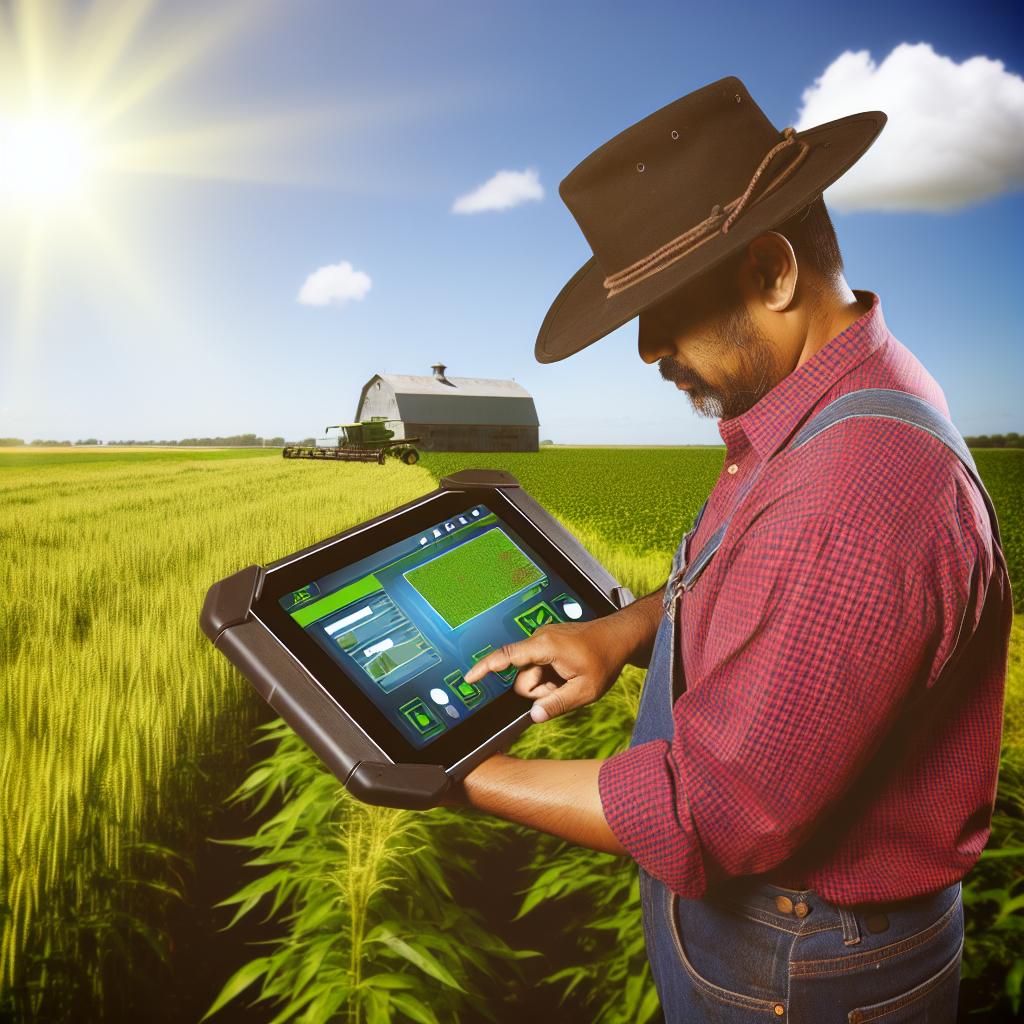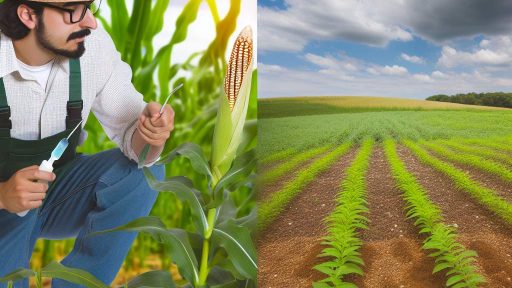Introduction to Farm Management Software and Its Role in Agriculture
Farm management software revolutionizes agricultural practices.
It provides tools that streamline farm operations and enhance productivity.
This software assists farmers in planning, monitoring, and analyzing all activities.
As a result, it directly impacts crop planning efficiency.
Understanding the Importance of Farm Management Software
Farm management software plays a crucial role in decision-making.
It helps farmers utilize data effectively for better outcomes.
The software can track various metrics such as soil health and crop yields.
This systematic approach allows for informed strategic planning.
Moreover, it promotes resource optimization and minimizes waste.
Key Features of Farm Management Software
- Data analytics for improved crop selection.
- Weather forecasting tools for better planning.
- Budgeting and financial planning functionalities.
- Record-keeping for compliance and audits.
These features enable farmers to make proactive decisions.
Consequently, this reduces the risk of crop failure and enhances profitability.
Enhancing Communication and Collaboration
The software also improves communication within farming teams.
It allows real-time information sharing across devices.
This level of transparency fosters collaboration among workers.
As a result, it leads to better coordination during peak seasons.
Transform Your Agribusiness
Unlock your farm's potential with expert advice tailored to your needs. Get actionable steps that drive real results.
Get StartedFarmers can benefit from a unified platform for all stakeholders.
Impact on Sustainable Agriculture
Farm management software encourages sustainable agricultural practices.
It assists in tracking resource usage and minimizing environmental impact.
Farmers can analyze data to adopt eco-friendly methods.
Ultimately, this contributes to long-term land health and productivity.
Overview of Crop Planning Processes in Modern Farming
Importance of Effective Crop Planning
Effective crop planning is crucial for maximizing yield and profitability.
Farmers must consider various factors to achieve optimal results.
These factors include soil health, climate conditions, and market demand.
Additionally, integrated management practices play a key role.
Essential Steps in Crop Planning
The crop planning process begins with soil analysis.
Farmers evaluate soil nutrient levels and composition.
This data informs the selection of appropriate crops.
Next, farmers create a planting schedule based on weather forecasts.
Moreover, crop rotation strategies help in maintaining soil health.
This method reduces pest pressure and promotes biodiversity.
Using Technology to Enhance Crop Planning
Modern farming increasingly relies on technology for planning efficiency.
Farm management software streamlines the planning process.
Farmers can track crop performance and adjust plans as needed.
Data analytics also provide insights into market trends and pricing.
Consequently, farmers can make informed decisions quickly.
Collaboration with Experts
Collaboration with agricultural experts enhances the planning process.
Farmers can seek advice on best practices and emerging trends.
This collaboration ensures a more comprehensive approach to planning.
Workshops and training sessions provide valuable knowledge.
Showcase Your Farming Business
Publish your professional farming services profile on our blog for a one-time fee of $200 and reach a dedicated audience of farmers and agribusiness owners.
Publish Your ProfileUltimately, informed farmers are better prepared for challenges.
Key Features of Farm Management Software that Boost Crop Planning Efficiency
Centralized Data Management
Farm management software centralizes all critical data in one place.
This feature eliminates the need for multiple spreadsheets and papers.
Users can easily access historical data and current conditions.
As a result, decision-making becomes faster and more informed.
Crop Rotation Planning
Effective software includes tools for crop rotation planning.
These tools help farmers maintain soil health and yield quality.
Additionally, users can predict pest cycles and disease outbreaks.
This proactive approach enhances long-term productivity.
Weather Integration
Weather integration offers real-time updates on climatic conditions.
Farmers can adjust their crop planning based on current forecasts.
This feature minimizes the risks associated with unpredictable weather.
Moreover, it allows for better timing of planting and harvesting.
Resource Management
Effective resource management is vital for efficient crop planning.
Software tracks inventory levels of seeds, fertilizers, and pesticides.
This tracking helps in planning purchasing decisions optimally.
As a result, users can reduce waste and manage costs efficiently.
Task Scheduling and Tracking
Task scheduling tools enable farmers to organize daily operations.
Employees receive notifications regarding their responsibilities.
This structured approach increases overall productivity on the farm.
Additionally, tracking task completion helps identify areas for improvement.
Data Analytics and Reporting
Data analytics features provide insights into crop performance.
Farmers can generate reports to evaluate historical data trends.
This information assists in refining future crop planning strategies.
Ultimately, it leads to improved yields and profitability.
Mobile Access
Mobile access allows farmers to manage their operations on the go.
This convenience ensures farmers stay connected regardless of location.
It streamlines communication among team members as well.
Farmers can respond quickly to any evolving situations or challenges.
Uncover the Details: Maximizing Crop Yields with Controlled Environment Agriculture
Benefits of Real-Time Data Collection and Analysis in Crop Planning
Improved Decision-Making
Real-time data enhances decision-making for farmers.
They can adjust strategies based on immediate insights.
This allows for timely interventions to optimize yields.
Farmers can quickly respond to environmental changes.
Moreover, they make informed choices about resource allocation.
Increased Yield Predictions
Crops thrive when farmers use accurate yield predictions.
Real-time data provides insights into growth patterns.
Farmers can assess which techniques work best over time.
Additionally, they can anticipate market demands effectively.
Enhanced Resource Efficiency
Real-time analytics ensure optimal resource use.
Showcase Your Farming Business
Publish your professional farming services profile on our blog for a one-time fee of $200 and reach a dedicated audience of farmers and agribusiness owners.
Publish Your ProfileFarmers can precisely apply water, fertilizers, and pesticides.
This reduces waste and lowers input costs significantly.
Consequently, it leads to better environmental stewardship.
Streamlined Operations
Data collection simplifies daily farming operations.
Farmers can automate tasks based on real-time feedback.
This approach saves time and decreases manual labor.
Additionally, it allows farmers to focus on strategy over routine.
Long-Term Sustainability
By utilizing real-time data, farmers promote sustainability.
They can monitor soil health and ecosystem changes.
This awareness helps preserve agricultural resources for future use.
Furthermore, it supports compliance with environmental regulations.
Find Out More: Streamlining Agricultural Payments Using Blockchain Technology
How Farm Management Software Facilitates Better Resource Allocation
Improved Data Analysis
Farm management software streamlines data collection for farmers.
It captures real-time information on crop health and soil conditions.
Additionally, it allows for accurate forecasting of resource needs.
Farmers can analyze weather patterns and historical yield data.
This analysis informs better planning and decision-making.
Efficient Inventory Management
Farm management software helps maintain optimal inventory levels.
It tracks inputs like seeds, fertilizers, and pesticides efficiently.
Farmers can avoid overstocking or understocking critical items.
Moreover, it alerts users when supplies run low.
This ensures timely procurement and reduces waste.
Cost-Effective Resource Allocation
Software tools assist in budgeting for various farm operations.
They help identify which resources yield the best returns.
Farmers can better allocate labor and machinery based on need.
Consequently, this leads to cost savings across farm activities.
Farmland allocations can also be optimized through precise planning.
Enhanced Operational Efficiency
Using farm management software reduces time spent on administrative tasks.
Automation of routine processes means less manual input for farmers.
Farmers can focus their time on strategic planning instead.
This shift increases overall productivity across the farm.
Ultimately, it enhances profitability and sustainability as well.
See Related Content: Sustainable Agriculture Through Biotechnology Innovations

Case Studies: Successful Implementation of Crop Planning Software
Green Valley Farms
Green Valley Farms adopted crop planning software last year.
This decision significantly improved their operational efficiency.
Using the software, they streamlined their planting schedules.
As a result, they maximized their yield potential.
The team noticed a 20% increase in overall productivity.
Additionally, the software helped them manage resources better.
They reduced waste and increased profitability through precise planning.
Showcase Your Farming Business
Publish your professional farming services profile on our blog for a one-time fee of $200 and reach a dedicated audience of farmers and agribusiness owners.
Publish Your ProfileSunrise Agriculture Co.
Sunrise Agriculture Co. experienced challenges with crop rotation.
They implemented crop planning software to address these issues.
Consequently, they could analyze soil health and fertility data effectively.
This allowed them to make informed decisions for crop rotations.
Ultimately, their harvests improved in quality and quantity.
Stakeholders reported greater customer satisfaction as well.
The investment paid off within just one growing season.
Harvest Innovations
Harvest Innovations focused on precision agriculture techniques.
Integrating crop planning software enhanced their efficiency.
Field mapping capabilities improved their planting strategies.
They achieved more accurate assessments of land use.
Consequently, their operational costs decreased significantly.
Moreover, they were able to predict market demands more accurately.
This foresight allowed them to adjust their production in advance.
EcoField Solutions
EcoField Solutions faced challenges in meeting sustainable practices.
They introduced crop planning software as part of their strategy.
The software assisted them in analyzing environmental impacts.
This way, they minimized pesticides and fertilizers effectively.
Farmers reported enhanced soil health over the seasons.
Overall, they achieved a notable reduction in their carbon footprint.
Such benefits attracted new partnerships with eco-conscious brands.
Explore Further: Benefits Of Using Farm Management Software On Modern Farms
Challenges and Considerations When Choosing Farm Management Software
Identifying Your Needs
Understanding your specific farm needs is crucial.
Start by evaluating the size and type of your farming operation.
Consider the range of crops you manage.
Also, think about your current challenges in crop planning.
This exploration will guide your software selection.
Assessing Software Features
Different software solutions offer various features.
Crucial functionalities include crop scheduling and inventory management.
Data analysis tools can enhance decision-making processes.
Additionally, cloud-based options offer real-time access to information.
Evaluate whether the software integrates with your existing systems.
Budget and Cost Considerations
Establishing a budget is essential in this process.
Software prices can vary widely based on features.
Consider both initial costs and ongoing subscription fees.
Compare potential software options against your financial limits.
Don’t forget to account for potential training expenses.
Vendor Reputation and Support
Selecting a reputable vendor ensures reliability.
Research and read customer reviews and testimonials.
Assess the level of customer service offered.
Showcase Your Farming Business
Publish your professional farming services profile on our blog for a one-time fee of $200 and reach a dedicated audience of farmers and agribusiness owners.
Publish Your ProfileLook for vendors that provide training and resources.
Quality support can significantly affect user experience.
Compatibility and Integration
Your software must work well with existing systems.
Investigate compatibility with your current hardware.
Check how easily it integrates with other tools you use.
Ensure you can easily transfer data to and from the software.
Smooth integration contributes to overall efficiency.
User-Friendliness and Accessibility
User-friendly software enhances engagement and productivity.
Evaluate the interface and navigation ease.
Seek feedback from your team on usability.
Also, consider mobile access for on-the-go management.
Accessibility is crucial for effective farm management.
Future Trends in Farm Management Software and Crop Planning Innovations
Integration of Artificial Intelligence
Artificial intelligence is revolutionizing farm management software.
Farmers can analyze large data sets more effectively with AI tools.
This technology predicts crop yields and suggests optimal planting times.
Consequently, farmers enhance their decision-making processes.
Advancements in Data Analytics
Data analytics capabilities are rapidly improving in farming software.
Tools can now provide real-time insights into various agricultural factors.
These include soil health, weather patterns, and pest outbreaks.
As a result, farmers can adjust their strategies quickly and efficiently.
Mobile-First Solutions
Mobile applications are becoming essential for farm management.
Farmers can access information and tools while on the go.
This mobility promotes greater responsiveness to changing conditions.
Furthermore, real-time data collection aids in informed decision-making.
Collaboration and Connectivity
Modern farm management software emphasizes collaboration among users.
This software connects farmers with agronomists and suppliers seamlessly.
As a result, teams can share vital insights and strategies effectively.
Connectivity also helps in managing supply chains more efficiently.
Sustainability Features
There is a growing emphasis on sustainable practices in farm management software.
Tools now include features for tracking resource usage and emissions.
Farmers can manage their environmental impact while maximizing yields.
This innovative focus is creating a more sustainable agricultural future.
Customization and Scalability
Customization options are crucial for modern farm management software.
Farmers can tailor solutions to their specific needs and goals.
Scalable systems support both small and large agricultural operations.
This flexibility enhances efficiency across diverse farming environments.
Additional Resources
Agtech: Breaking down the farmer adoption dilemma | McKinsey




